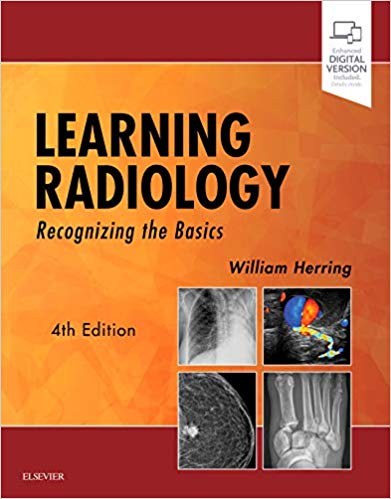Learning Radiology (2019) is an updated version of Learning Radiology (2011), which I reviewed elsewhere.
Much like the previous editions, Learning Radiology (2019) uses a pattern recognition approach through which learners are taught how to recognize pertinent features of radiographic images. The images shown are generally very highly characteristic, and the captions help accentuate and highlight all the pertinent radiographic findings.
Per the main author Dr. William Herring, additions to the 2019 edition include:
- Ultrasonography: a new chapter covering vascular and point-of-care ultrasound.
- Interventional radiology (IR): a new chapter on image-guided interventions, and the addition of a dozen new IR-relevant case scenarios interspersed throughout the book.
- Trauma: reorganization of trauma-related radiology into its own chapter (Emergency Radiology).
- Mammography: a new chapter.
In addition, as the author pointed out to me in a personal communication, the 2019 edition has many new images and many of the existing ones were reprocessed for greater clarity. The book therefore represents a very substantial and worthwhile upgrade from the previous editions.

Because of all these upgrades, I’m no longer sure that the book’s subtitle recognizing the basics remains appropriate. There’s a lot more here than mere recognition (e.g., interventional radiology) and there’s a lot more here than just basics (e.g., bone marrow edema cause by transient lateral patellar dislocation).
For these reasons, therefore, consideration should be given to removing the current subtitle recognizing the basics from future editions and rebranding the book as a full radiology curriculum for medical students and residents. In the alternative—or perhaps as an additional enhancement—effort should be undertaken to pair the material more closely with primary care concepts in general and the all-important USMLE mindset in particular. (For example, the current edition says nothing about pediatric bone tumors such as osteosarcoma or Ewing sarcoma, nor is there any mention of pyloric stenosis. And while there is a mention and a picture of supracondylar fracture, there is no discussion of the risk of median nerve injury or of Volkmann’s contracture. All these things need to be presented, fleshed out and discussed in the context of their clinical significance. These types of changes and discussions will further expand this books market share and further expand its appeal to average medical students and residents.
Despite the above-identified potential areas for improvement, Learning Radiology (2019) is an outstanding medical book. I highly recommend it to medical students, residents and attendings in a variety of medical and surgical specialties.
Disclosure: I received a courtesy copy from the publisher – with no strings attached.


Leave a Reply